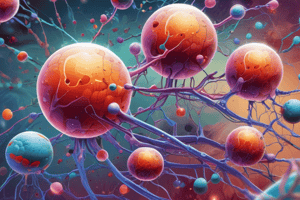Podcast
Questions and Answers
What is the primary difference between apoptosis and necrosis?
What is the primary difference between apoptosis and necrosis?
- Apoptosis occurs due to lack of ATP, while necrosis occurs due to physical damage.
- Apoptosis is regulated cell death, while necrosis is accidental cell death. (correct)
- Apoptosis occurs due to physical damage, while necrosis occurs due to lack of ATP.
- Apoptosis is accidental cell death, while necrosis is regulated cell death.
What is the role of apoptosis in tissue remodeling and development?
What is the role of apoptosis in tissue remodeling and development?
- To promote cell growth and division.
- To induce necrosis in adjacent cells.
- To remove excess cells and form mature tissues. (correct)
- To trigger inflammatory responses.
What is a characteristic of necrosis?
What is a characteristic of necrosis?
- Cells die due to lack of ATP or physical damage. (correct)
- Cell contents are not released into the extracellular space.
- Cells die in a controlled manner.
- No inflammatory response is triggered.
What is the term for the process by which cells die in a controlled manner?
What is the term for the process by which cells die in a controlled manner?
What is the result of apoptosis in terms of inflammatory response?
What is the result of apoptosis in terms of inflammatory response?
What is the term for the process by which cells die due to lack of ATP or physical damage?
What is the term for the process by which cells die due to lack of ATP or physical damage?
What is the result of necrosis in terms of cell contents?
What is the result of necrosis in terms of cell contents?
What is a trigger of apoptosis?
What is a trigger of apoptosis?
What is the primary function of iCAD?
What is the primary function of iCAD?
What is the result of DNA fragmentation during apoptosis?
What is the result of DNA fragmentation during apoptosis?
What triggers the caspase cascade in the extrinsic pathway?
What triggers the caspase cascade in the extrinsic pathway?
What is the function of executioner caspases?
What is the function of executioner caspases?
What is the name of the complex formed after the binding of Fas ligand to Fas receptor?
What is the name of the complex formed after the binding of Fas ligand to Fas receptor?
What is the name of the receptor family that death receptors belong to?
What is the name of the receptor family that death receptors belong to?
What is the result of caspase degradation of iCAD?
What is the result of caspase degradation of iCAD?
What is the name of the process triggered from outside the cell?
What is the name of the process triggered from outside the cell?
What is the primary function of phosphatidylserine in apoptosis?
What is the primary function of phosphatidylserine in apoptosis?
What is the role of survival factors in apoptosis?
What is the role of survival factors in apoptosis?
What is the primary function of apoptosis in response to excessive DNA damage?
What is the primary function of apoptosis in response to excessive DNA damage?
What is the outcome of caspase activation in apoptosis?
What is the outcome of caspase activation in apoptosis?
What type of radiation induces chemical bonds between adjacent thymines, leading to thymine dimers?
What type of radiation induces chemical bonds between adjacent thymines, leading to thymine dimers?
What is the consequence of Bax/Bak aggregation?
What is the consequence of Bax/Bak aggregation?
What is the primary function of initiator caspases in the apoptotic pathway?
What is the primary function of initiator caspases in the apoptotic pathway?
Why are survival factors important during development?
Why are survival factors important during development?
What is the result of thymine dimers on DNA structure?
What is the result of thymine dimers on DNA structure?
What is the importance of phagocytosis in apoptosis?
What is the importance of phagocytosis in apoptosis?
What is the fate of apoptotic cells?
What is the fate of apoptotic cells?
What is the morphological change observed during apoptosis where the cell surface bulges?
What is the morphological change observed during apoptosis where the cell surface bulges?
What is the role of executor caspases in the apoptotic pathway?
What is the role of executor caspases in the apoptotic pathway?
What is the result of excessive DNA damage on skin keratinocytes?
What is the result of excessive DNA damage on skin keratinocytes?
What is the primary mechanism that contributes to the development of cancers?
What is the primary mechanism that contributes to the development of cancers?
What is often found at the centre of solid tumours?
What is often found at the centre of solid tumours?
What is the result of a decrease in apoptosis in the development of cancers?
What is the result of a decrease in apoptosis in the development of cancers?
What is a key factor that regulates the development of cancers?
What is a key factor that regulates the development of cancers?
What is the primary mechanism that leads to the development of solid tumours?
What is the primary mechanism that leads to the development of solid tumours?
What is the importance of apoptosis in the development of cancers?
What is the importance of apoptosis in the development of cancers?
Flashcards are hidden until you start studying
Study Notes
Cell Death
- Apoptosis: Regulated cell death (RCD) or Programmed Cell Death (PCD) where cells die in a controlled way, and their contents are not released, triggering no inflammatory response.
- Necrosis: Accidental cell death (ACD) due to lack of ATP, physical damage, or injury, where cell contents are released, triggering an inflammatory response.
Role of Apoptosis
- In tissue re-modelling and development: Removes excess cells to form mature tissues, e.g., during metamorphosis, limb development, and establishment of the adaptive immune system.
- In removing damaged cells: Prevents cancer development by eliminating cells with excessive DNA damage, such as those exposed to UVB radiation.
Morphological Changes during Apoptosis
- Cells become smaller
- Cytoskeleton collapses
- Nuclear envelope disassembles
- Chromatin condenses and is fragmented
- Cell surface bulges (blebs)
- Cells break up into membrane-bound "apoptotic bodies"
- Apoptotic bodies are engulfed and destroyed by phagocytosis by macrophages
Caspases – Intracellular Mediators of Apoptosis
- A family of proteases that trigger a sequence of intracellular events leading to apoptosis
- Initiator caspases:Inactive monomers in the cytosol that are activated by cleavage during apoptosis
- Executor caspases: Activated by initiator caspases, which then activate all the changes in cell biology observed in apoptosis
DNA Fragmentation
- Activated by caspases, which cleave and activate the endonuclease CAD
- DNA is cleaved in the regions between nucleosomes, resulting in a ladder of fragments
Extrinsic Pathway to Trigger Apoptosis
- Activation of death receptors on the cell surface, such as the Fas receptor
- Binding of Fas ligand to the Fas receptor activates the caspase cascade
Removal of Apoptotic Cell by Macrophage
- Cells undergoing apoptosis are detected and removed by phagocytosis
- Phosphatidylserine (PS) is flipped to the outer leaf of the plasma membrane, triggering phagocytosis
Survival Factors
- Block apoptosis by interfering with Bax/Bak aggregation
- Examples: Bcl2
- Most cells require continuous signalling by survival factors produced by neighbouring cells to block apoptosis
Apoptosis and Cancer
- Cancers are caused by an excessive number of cells due to mutations and decreased apoptosis
- Increase in cell division or decrease in apoptosis can contribute to cancer development
- At the centre of solid tumours, a necrotic core often forms due to a lack of blood supply
Studying That Suits You
Use AI to generate personalized quizzes and flashcards to suit your learning preferences.




